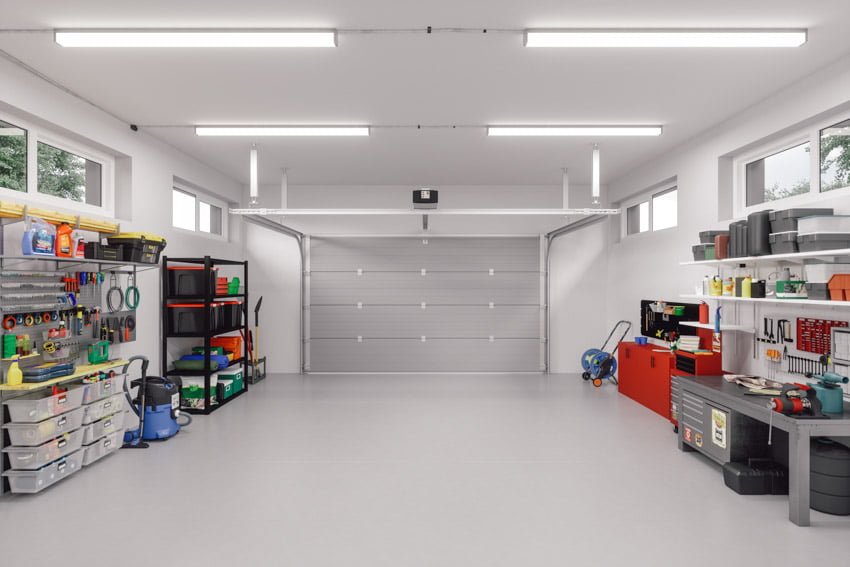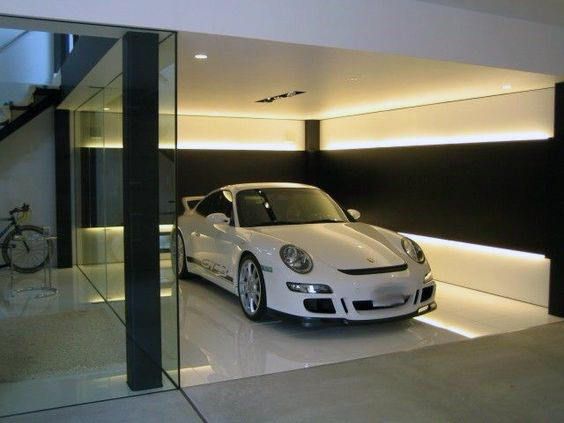Contact us for quotation
Let's have a chat
Let's have a chat
The significance of a garage is clear to anyone considering buying a home. It serves various functions within the household, offering storage and workspace and accommodating everything from tools and pool accessories to lawn equipment and cars. Each item has its designated place and role within this space.

Despite often being overlooked, garage lighting is as crucial to the overall design of the garage as any organizational structure.
Let’s delve deeper into lighting, understand its importance, and discuss the choices for effective garage illumination.
To understand why lighting a garage adequately is essential, you must comprehend its importance. While the primary function of garages is to park cars, requiring little attention to lighting, they are also used for storing equipment, supplies, and other household items. This extends the garage’s function beyond merely providing parking, making it a vital part of the home. Therefore, just like every other part of the house, the garage deserves thoughtful consideration whregardingighting.
Effective garage lighting not only improves its utility but also enhances safety. There will be no need for portable LED lights during quick fixes, and storing and accessing supplies will become easier. A well-lit garage minimizes the risk of accidents during quick repairs and allows clear visibility, reducing the chances of injuries.
Additionally, adequate lighting makes parking and exiting easier, preventing scratches from narrow garage walls. Therefore, when contemplating a garage upgrade, start with enhancing the lighting.
There are several lighting options to consider when looking for garage light fixtures. Here are a few popular choices:
LEDs, or Light Emitting Diodes, should be at the top of your list when considering garage lighting. LEDs offer significant advantages, including lower energy consumption and longer lifespan than cothanncandescent and fluorescent bulbs. LEDs use about 75% less energy and typically last 80% longer.
LED lighting reduces your energy use and spares frequent bulb replacement. LEDs come in various shapes and sizes, providing flexibility to create effective garage lighting dedesignsHowever, LEDs emit light in one direction, requiring multiple fixtures for comprehensive garage lighting.
Fluorescent lights are ideal for lighting large areas, making them suitable for commercial or spacious garages. They use mercury vapor-based tubes to produce light when ionized by an electrical current. They also include inert gas and phosphorous coating.
Fluorescent lights emit diverse wavelengths, covering large areas effectively. However, the heat generated during ionization can damage the fixture, and the lifespan of such lights is shorter than LEDs.
Incandescent bulbs, although popular due to their low cost, are the least efficient option for lighting any space. They utilize a heated filament to produce light but are fragile and require frequent replacement. Moreover, they consume a lot of energy, increasing utility bills.
While similar in design to incandescent bulbs, halogen lights are slightly more advanced. They emit white light that is less straining to the eyes, consume less energy, and have a longer lifespan. However, when compared to LEDs, halogen lights consume more power and have a shorter lifespan.

Outfitting a garage with suitable lighting design and fixtures brings many benefits. Here are the most notable:
It’s no secret that using a garage extends beyond merely vehicle storage. Still, adequate lighting is a must to exploit this multi-purpose potential fullyWith the right illumination; your garage can seamlessly transform into a handy workshop, enabling tasks like minor vehicle repairs or electronic tinkering.
A superior lighting setup enhances the garage’s workflow and magnifies visibility, thus minimizing errors. Have you lost a tiny component? No worries! A well-lit area ensures you spot misplaced items with ease.
This advantage primarily resonates with commercial garage owners whither lights are operational for long hours. The right lighting solution means fewer replacements; even with constant daily usagePlus, attractive lighting could point in more customers, positively impacting your revenue.
The quality of light also has a notable effect on staff morale. Adequate lighting keeps staff alert and motivated, while subpar lighting can induce drowsiness, hampering productivity.
Efficient lighting systems draw less power, reducing your energy bills. This economic aspect benefits residential garages but is particularly significant for commercial ones, where lights are kept on for extended periods. A cost-effective lighting arrangement can leyieldubstantial savings, potentially contributing to increased business productivity.
For instance, LED lights use about 80% less energy than incandescent bulbs. This means a potential reduction of up to 80% in your energy costs if lighting is the primary electricity consumer in your space.

Equipped with the fundamentals of garage lighting, let’s explore how to optimize your lighting setup.
The initial step in garage lighting is choosing the right fixtures. Many options are available, but the most suitable choice varies based on individual needs. Although LEDs might be an ideal choice for many, personal preference or specific requirements might dictate otherwise.
Before finalizing your design, choose your fixtures. Different lights have distinct characteristics that influence the overall ambiance of your garage. For instance, incandescent bulbs yield a yellowish light, whereas LEDs produce a whiter shade. Therefore, your fixture choice will determine the final appearance of your garage.
Light output, measured in lumens, determines a bulb’s brightness. Although light requirements vary from place to place, a general rule of thumb suggests 5 lumens per square foot for most garages. To calculate the number of lights needed for your garage, simply multiply the total square footage by five.
Once you have this figure, you can start sourcing fixtures that provide the required light output. Remember, especially when dealing with LEDs, that you may need multiple fixtures to illuminate all areas of your garage adequately.
Color temperature, measured on the Kelvin scale (ranging from 1,000 to 10,000), denotes a light’s color and can influence a space’s mood and overall atmosphere. For example, lights with a temperature below 3,000K produce a warm, cozy light that isn’t optimal for workspaces. On the other hand, lights above 4,000K are cooler and resemble natural light, making occupants feel more alert.
Therefore, when lighting a garage, aim for fixtures with a color temperature of around 5,000K.
Have you ever noticed an item looking different under store lighting, both natural light? This happens due to the store’s low color rendering index (CRI). CRI measures how accurately a light source can replicate natural light, showing the true colors of objects under it.
On a scale of 0-100, the closer to 100, the more natural the colors appear. Aim for lights with a CRI of 80 or more for effective garage lighting.
When planning your garage lighting, consider the color of your walls. Bright walls reflect light so lower-lumen solutions may be sufficient. However, darker walls absorb light, necessitating higher-lumen fixtures.
Given the significant role a garage plays in a household, comparable to that of the living room, bedrooms, or bathrooms, it is crucial to ensure optimal lighting for its effective use. This necessity is magnified in commercial premises. The challenge is to find lighting solutions that deliver maximum functionality without escalating energy costs. Hopefully, this article has highlighted viable alternatives to meet that goal.
MyLikeLed is a renowned manufacturer of superior LED strips and LED neon flex. Our offerings are subjected to rigorous testing in state-of-the-art labs to ensure top-tier quality. In addition, we provide personalized solutions for our LED strips and neon flex. Thus, for the finest LED strips and LED neon flex, get in touch with MyLikeLed at your earliest convenience!
We understand that every project is unique. That’s why we offer tailored LED strip solutions to meet your specific requirements.
Copyright © 2024 – My Like Led All rights reserved.
Let's have a chat